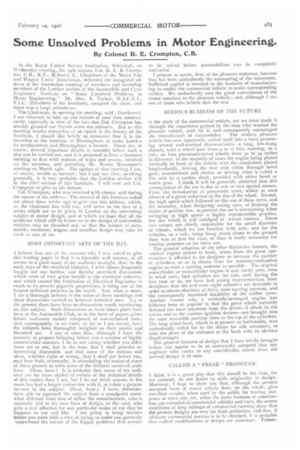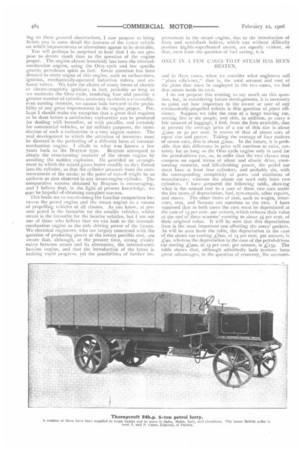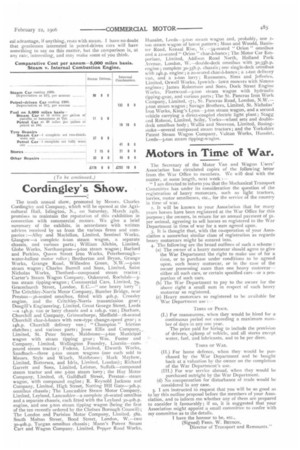Some Unsolved Problems in Motor Engineering.
Page 11

Page 12

Page 13

If you've noticed an error in this article please click here to report it so we can fix it.
By Colonel R. E. Crompton, C.B.
At the Royal United Service Institution, Whitehall, on Wednesday evening, the 14th instant, Col. R. E. B. Cromp
ton, C.B., R.E., M.Inst.C.E., Chairman of the Motor Van and Wagon Users' Association, delivered the inaugural address at the foundation meeting of members and intending
members of the London section of the Automobile and Cycle Engineers' Institute on " Some Unsolved Problems in Motor Engineering." Mr. Alex. E. Tucker, M.A.C.E.I., F.I.C. (President of the Institute), occupied the chair, and there was a large attendance.
The Chairman, in opening the meeting, said : Gentlemen, am reluctant to take up one minute of your time unnecessarily, especially in view of the fact that Col. Crompton has already granted our friends some ten minutes. But as this meeting marks somewhat of an epoch in the history of the Institute, I should like briefly to announce that it is the intention of the Institute in Birmingham to make London its headquarters and Birmingham a branch. There are, of course, several important details to consider before such a step can be carried out, and it is proposed to have a business meeting to deal with matters of ways and means, involved on the occasion, and preceding Mr. Worby Beaumont's meeting on March 14th. The upshot of that meeting I am, ol course, unable to forecast ; but I can say that, speaking generally, it is very probable that the London section will be the chief section of this Institute. I will now ask Col. Crompton to give us his lecture.
Col. Crompton, who was received with cheers, said during the course of his address : The council of this Institute asked me about three weeks ago to give you this address, which, as the chairman has told you, will serve as the first of a, series which are to be given in London on the interesting subject of motor design, and at which we hope that all the problems which still lie before us in the design of automobile vehicles may be thrashed out, so that the science of automobile, motorcar, wagon and omnibus design may take its rank as one of the
MOST IMPORTANT ARTS OF THE DAY.
I believe that one of the reasons why I wits asked to give this leading paper is that it is tolerably well known, at all events to a good many of my audience to-night, that, in the early days of the electrical industry, I with others frequently fought out our battles, and thereby provoked discussions which were of very great benefit to the electrical industry, and which caused the Institution of Electrical Engineers to reach to its present gigantic proportions, it being one of the largest technical societies in the world. And, what is more, I am a thorough believer in the value of these meetings and these discussions carried on between technical men. Up to the present there have been no discussions worth mentioning on this subject. Such discussions as have taken place have been at the Automobile Club, or in the form of papers given before audiences mainly composed of non-technical men; and, consequently, in no cases, as far as I am aware, have the subjects been thoroughly weighed on their merits and
thrashed out. I say at once that, although I have the temerity to propose bringing before you a number of highly controversial matters, I do so not caring whether you differ from me or not, but in the hope that I shall provoke an interesting discussion, and that sonic of the notions and ideas, whether right or wrong, that I shall put before you, may bear fruit, eventually, in stimulating the brains of many of those present to solve some of the hitherto unsolved problems. (Hear, hear.) It is probable that many of my audience are far more skilled in certain of the technical details of this matter than I am, but I do not think anyone in the room has had a longer connection with it, or taken a greater interest in the subject. (Hear, hear.) 1 have, therefore, been able to approach the subject from a standpoint somewhat different from that of either the manufacturer, who is naturally tied to his own lines of design, or the user, who gets a real affection for any particular make of car that he happens to use and like. I am going to bring matters before you more with a view of trying to make you generally orriprehend the nature of the bigger problems that remain
to be solved before automobilism can be completely successful.
I propose to speak, first, of the pleasure motorcar, because that has been undoubtedly the mainspring of the movement. Sufficient capital is invested in the business of manufacturing to enable the commercial vehicle to make corresponding strides. We undoubtedly owe the great convenience of the motor omnibus to the pleasure vehicle; and, although I am one of those who believe that the real SERIOUS BUSINESS OF THE FUTURE
is the study of the commercial vehicle, yet we must study it through the experience gained by the men who wanted the pleasure vehicle, paid for it, and consequently encouraged the manufacture of automobiles. The modern pleasure vehicle has now apparently settled itself into a form presenting several well-marked characteristics--a long, low-hung chassis, with a wheel base from 9 to 12 feet, running, as a rule, on tour pneumatic-tyred wheels from 30 to 34 inches in diameter, in the majority of cases the engine being placed vertically in front of the vehicle with the crankshaft placed longitudinally, driving the rear axle either through bevel gear, countershaft and chains, or driving what is called a live axle by a cardan shaft, provided with either bevel or worm gear. I think it will be generally admitted that this arrangement of the car is due to one or two special causes. First, the introduction of pneumatic tyres, which at once allowed of a great reduction in the size of the wheel. Second, the high speed which followed on the use of these tyres, and the necessity, when designing racingcars, of keeping the centre of gravity low, to prevent the car's overturning when swinging at high speed--a highly reprehensible practice, but one which is still indulged in -round corners. These two causes are chiefly responsible for the small diameter of wheels, which we are familiar with now, and for the vehicles, as a rule, being hung much closer to the ground than was at first the case, or than is really necessary for touring purposes or for town use.
The general adoption of the other distinctive feature, the vertical engine placed in front, arises from the great convenience it afforded to the designer to increase the number of cyiinders, so as to obtain from the internal-combustionengine as even a turning moment as possible. The original one-cylinder or two-cylinder engine is now rarely seen, evenin small cars; four cylinders are the rule, and, during the last year or so, we have had strong representations from designers that six and even eight cylinders are desirable in order to obtain elasticity of drive, even turning moment, and the consequently increased durability of the rubber tyres. Another reason why a vertically-arranged engine has hitherto been so popular is that the parts which certainly demand the most attention from the driver—I allude to the valves and to the various ignition devices—are brought into the most accessible position close to the top of the cylinders. The long wheel base, which is at present so fashionable, was undoubtedly called for by the desire for side entrances, to take the place of the entrance at the back with its obvious disadvantages. The general features of design that I have briefly brought before vou appear to be so universally accepted that any engineer who varies to any considerable extent from the normal design is at once CALLED A " FREAK " PRODUCER.
I think it is a great pity that this should be the case, for we certainly do not desire to stifle originality in design. Moreover, 1 hope to show you that, although the present accepted form of motor vehicle does, on the whole, give excellent results, when used by the public for touring purposes or town use, yet, when the same features of construetion are extended to commercial vehicles and vans, the severe conditions of long mileage of commercial running show that the present designs are very far from perfection, and that, if ultimate commercial success is to be obtained, it is probable. that radical modifications of design are necessary. Follow
ing on these general observations, I. now propose to bring before you in some detail the features of the motor vehicle on which improvements Or alterations appear to be desirable. You will perhaps be surprised to hear that I do not propose to devote much time to the question of the engine proper. The engine almost invariably has been the internalcombustion engine, using the Otto cycle and low specific gravity petroleum spirit as fuel. Great attention has been -devoted to every organ of this engine, such as carburetters, ignition, mechanically-operated induction valves, and exhaust valves. We have the choice of many forms of electric or electro-magnetic ignition ; in fact, probably so long as we maintain the Otto cycle, rendering four and possibly a greater number of cylinders necessary to obtain a reasonablyeven turning moment, we cannot look forward to die probability of any great improvement in the engine proper. Perhaps I should make the exception that a great deal requires to be done before a satisfactory carburetter can be produced for dealing with benzoline, or with paraffin, and certainly for commercial vehicles, or for military purposes, the introduction of such a carburetter is a very urgent matter. The real development to which the attention of inventors must be directed is the perfectingof a different form of internalcombustion engine. I allude to what was known a few
years back as the Brayton type. Brayton attempted to obtain the even-turning moment of the steam engine by avoiding the sudden explosion. 1 le provided an arrangement by which the mixed gases burnt steadily as they flowed into the cylinder, so that the cylinder pressure from the commencement of the stroke to the point of cut-off might be as uniform as that observed in any steam-engine cylinder. The comparative success obtained by Brayton is encouraging, and I believe that, in the light of present knowledge, we may be hopeful of obtaining complete success.
This leads me to meationning the familiar comparison between the petrol engine and the steam engine as a means of propelling vehicles of all classes. As you know, at present petrol is the favourite for the smaller vehicles, whilst steam is the favourite for the heavier vehicles, but 1 am not one of those who believe that we can look to the internal-combustion engine as the only driving power of the future. We electrical engineers, who are largely concerned with the question of producing power at the lowest possible Cost, are aware that, although, at the present time, strong rivalry exists between steam and its alternative, the internal-combustion engine, and that the introduction of the latter is making rapid progress, yet the possibilities of further im
provement in the steam engine, due to the introduction of fflish and semi-liash boilers, which can without difficulty pm educe highly-superheated steam, are equally evident, so I hat, even from the question of fuel saving, it is ONLY IN A FEW CASES THAT STEAM 'LAS BEEN BEATEN, :old in these cases, when we consider what engineers call " plant efficiency," that is, the total amount and cost of the plant that must be employed in the two cases, we find Mai _steam holds its oN\n.
I do not propose this evening to say much on this question, but, in considering future developments, it is necessary to point out how important to theowner or user of any mechanically-propelled vehicle is this question of plant efficiency. Suppose we take the case of a large touring car, seating live or six people, and able, in addition, to carry a fair amount of luggage, I find, from the lists available, that at present the average price of a car of this size is about L9oo, or 5o per cent, in excess of that of steam cars of equal size and power. Taking the average of four makers of steam cars, this is about kboo. In the future, it is probable that this difference in price will continue to exist, certainly for as long as the Otto cycle engine only is used for the petrol-driven car, as, in order that the two classes may compete on equal terms of silent and elastic drive, eventurning moment, and hill-climbing power, the petrol car must have at least four cylinders, and probably six, with the corresponding complexity of parts and costliness of manufacture, whereas the steam car need only have two cylinders. 1 have prepared the following table, showing what is the annual cost to a user of these two cars under the live items of depreciation, fuel, tyre-repair, other repairs, and stores. The other items of cost, such as wages, insurance, rent, and licenses are common to the two. I have supposed that in both cases the cars must be depreciated at the rate of 15 per cent. per annum, which reduces their value at the end of three seasons' running to about per cent, of their original value. It will be seen that this depreciation item is the most important one affecting the users' pockets. As will be seen from the table, the depreciation in the case of the steam car costing ,4:600, at 15 per cent. per annum, is .-.,/,;go, whereas the depreciation in the case of the petrol-driven car costing kgoo, at 15 per cent, per annum, is k'135. The table shows that, although admittedly both systems have great advantages, in the question of economy, the economi cal advantage, if anything, rests with steam. I have no doubt that gentlemen interested in petrol-driven cars will have something to say on this matter, but the comparison is, at any rate, interesting, and may make some of you think.




















